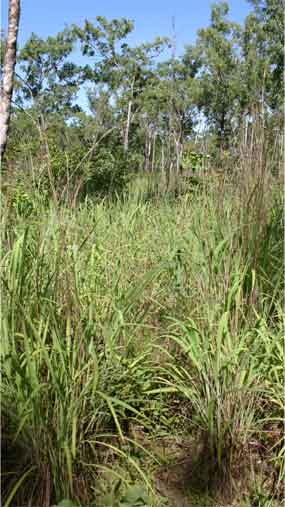Managing fire in a changing world
The landscapes of northern Australia are subject to constant changes and new threats. These threats include global warming and invasive species. Both climate change and invasive species have the potential to alter fire regimes, and thus have major implications for fire management.
Global warming may alter rainfall and seasonal weather which, in conjunction, with a rise in atmospheric carbon dioxide could influence fuel loads and fire seasonality, and hence fire intensities. The consequence for fire management could be profound, although predictions vary (see Impacts of fire on landscape and atmosphere in the Ecology section).
Invasive plant species can also dramatically influence prevailing fire regimes through changes in fuel loads and differential curing rates. Hence, any management approach typically associated with these areas will also be affected.
Hot topic: Invasive grasses and fire
Gamba grass (Andropogon gayanus) was originally introduced to the Northern Territory savannas from Africa. It is an extremely productive and valued pasture grass, and was introduced for use in grazed systems. However, it is now established and spreading outside of grazed systems, where it is becoming a significant environmental weed. It is common around Darwin, and becoming increasingly common along road verges to the south. Unplanned establishments have now been recorded in Queensland.
Gamba grass in the Top End savannas
Charles Darwin University researchers are investigating the affects of gamba grass on savanna ecosystem function, including on savannas fires. They have found that have found that gamba grass produced much higher fuel loads than native grasses, producing up to 10 times the biomass of native grasses. It grows in excess of 4.5 m high, and unlike native grasses, it remains upright throughout the fire season, creating a tall standing fuel load.
Anecdotal evidence suggests that gamba grass dries later in the dry season than native grasses. High fuel loads in the mid to late dry season, have the potential to produce intense, late-dry season fires. Others have speculated that the high fuel loads of gamba grass can build up in a single growing season, supporting fires every year, and sometimes twice a year (Cook 1991).
These new fire regimes have the potential to initiate a grass–fire cycle on a broad scale in the savannas of northern Australia. Fire intensity in the early dry season in savannas invaded by gamba grass is up to 12 times higher than that in native grass savannas (Rossiter et al. 2003).
For more detailed information on gamba grass and its management in non-grazing systems, refer to the following readings and resources.
Readings :
Howard, T. (2002) Exotic grasses and fire. In: Savanna Burning: Understanding and Using Fire in Northern Australia (R. Dyer, P. Jacklyn, I. Partidge, J. Russell-Smith and R. J. Williams, eds.), p.25. Tropical Savannas CRC, Darwin.
Rossiter, N. A., Setterfield, S. A., Douglas, M. M., and Hutley, L. B. (2003) Testing the grass-fire cycle: alien grass invasion in the tropical savannas of northern Australia. Diversity and distributions 9:169-176.
Further readings:
Bowman, D. (1999) Introduced grasses: triumph or Trojan horse? Savanna Links 10.
Howard, T. (2000) Introduced grasses: poor master, but useful servant. Savanna Links 16.
Quirk, M. (1999) Cut and dried: the issue is how to manage disturbance. Savanna Links10.
Rossiter, N. (undated) The impacts of invasive grasses on ecosystem processes in Australia's savannas.
Management Assessment
For this assessment activity, you will need to write a review of the objectives and implementation of fire management by major land users in northern Australia, and outline common ground and potential conflicts between these.
Use notes and readings from the modules on policy and management, particularly the first ‘Management’ activity (‘People, land & burning’), and the additionsl reference list (pdf document) provided, or other sources.
- What are the objectives of burning for Aboriginal people, pastoral land managers and conservation and biodiversity managers?
- Can the aims/objectives, and timing and application of fire sometimes differ within a land-use group? If so, how and why?
- Can you describe how the approach taken to burning differs between groups? Try to think about this in terms of aspects of the fire regime, fire type, and scale of burn.
Having now developed an understanding of different fire management aims and characteristics of the resultant fires, consider the common ground between groups as well as the potential points of conflict between land management groups? In terms of conflict think about:
- The types of regimes that land uses aim for
- What if a fire escapes from conservation reserve to a neighbouring pastoral or Aboriginal freehold area? What potential problems could this cause?
- How do the aims of burning differ and can they be reconciled?
Having briefly explored some of the options for community engagement, what community processes and principles would you recommend to ensure an effective and well-supported fire management planning process is developed?
Remember these questions are just to guide you. There may of course be other information you can include too. Although you can use the references from the first activity and reference list (pdf document) to guide and inform your reading you are encouraged to search for and use your own references as well.
![]()
